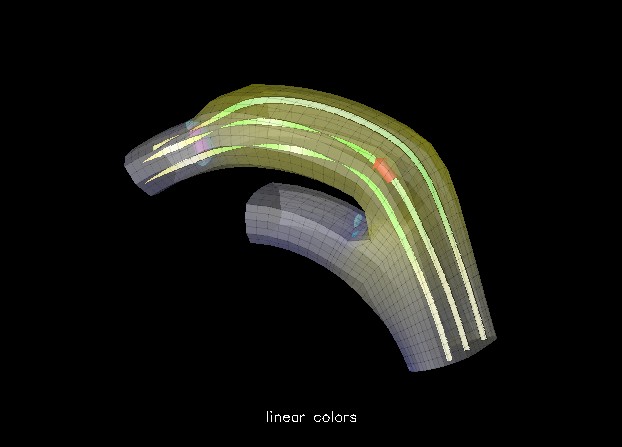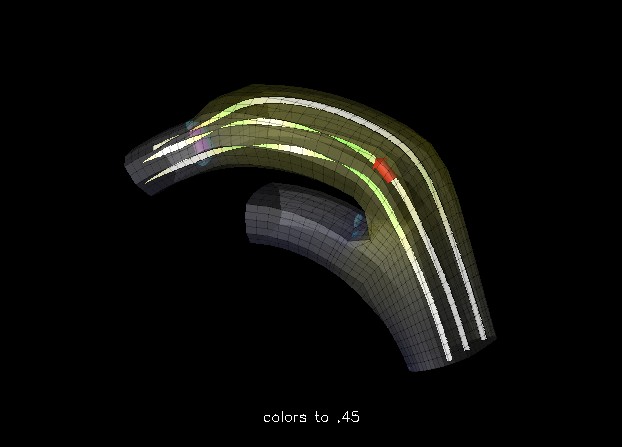 Fig. 1.
Fig. 1.In the general area of data visualization, VRML is a new way to distribute the results of a visualization beyond simple images and animations. The VRML "authoring tools" in this area have existed for years -- particularly in the areas of science and engineering. Tools to view finite element/finite difference analysis results, results of data acquisition systems, molecular modeling results, etc. have created colored, lit geometries for many years using OpenGL0like material specifications in a linear color space. These software systems are producing results now to distribute over the web by writing VRML exporters for their systems. While most visualization systems don't try to simulate lighting (although many CAD systems advertise "photorealistic" output), they use lighting to show depth, specular highlights to accentuate shape, and transparency to show multiple surfaces (e.g., multiple isosurfaces, or adjacent parts for context). The internal geometry viewers in visualization systems are not going to change to accomodate alternative color definitions from VRML. At best, they can try to adjust their current export functions to try to find equivalent VRML colors. For visualizations that depend on specularity and/or transparency, finding color equalivents may be impossible when the operations of addition, multiplication and exponentiation are changed.
The following example illustrates the differences one can get when rendering data visualizations with and without gamma correction.
 Fig. 1.
Fig. 1.
Figure 1 shows a standard rendering of a duct flow visualization using IBM's Data Explorer (DX). The visibility of lines inside and outside the translucent surface representing the duct is very important to the client, and even subtle changes in the colors can render certain aspects of this visualization invisible, defeating the purpose.
 Fig. 2.
Fig. 2.
Figure 2 shows a rendering of the same image using a compressed (2.2) color space. The input colors were each raised to the 0.45 power, and the output image was not gamma-corrected. When displayed on a standard CRT monitor, this image will be the closest match obtainable to Figure 1 without doing back end gamma correction.
The obvious differences in the two figures point out the problems with a compressed VRML color space. For VRML to be useful for visualization models, it needs to yeild the same results as was produced on the originating system. The rendering of transparency and other effects changes dramatically when the lighting equation is altered, and the resulting image(s) will not represent the same information as the visualization designer intended. The point here is not which figure looks better, but which figure maintains highest fidelity to the original visualization? Clearly, rendering in a compressed color space creates reproduction difficulties for data visualization.
Below are examples of current VRML export from various commercial products in the areas of general visualization, engineering and chemistry. The ability to export from these existing applications to a new color model for VRML should be considered before adopting a standard.
http://www.avs.com/products/web/products/express.htm
http://www.uniras.dk/info/seminars/Drilldown.htm
http://www.nag.co.uk/visual/IE/iecbb/Render/Issue9/vrml.html
http://www.nag.co.uk/visual/IE/iecbb/VRML2/wm1.html
http://www.nag.co.uk/visual/IE/iecbb/VRML2/isos.wrl
http://vislab.cam.nist.gov/~lipman/vrml/vrmlother.html
http://www.ansys.com/Products/DesignSpace/gallery2.htm
http://www.ansys.com/Products/DesignSpace/v.htm
http://www.cosmosm.com/vrml_gal.htm
http://www.sdrc.com/ref/vrml/index_vrml.html
This has lots of examples at the bottom of the page. They attempt to deal with color variations by having a color cube you can down load to adjust the lights with.
http://www.microcadam.com/gallery/vrml.html
http://www.nist.gov/itl/div894/ovrt/projects/mfg/SIMA/vrml97/vimhtml.fm.html
http://www.msi.com/info/products/modules/WLViewer.html
Questions, comments, etc.:
Holly Rushmeier